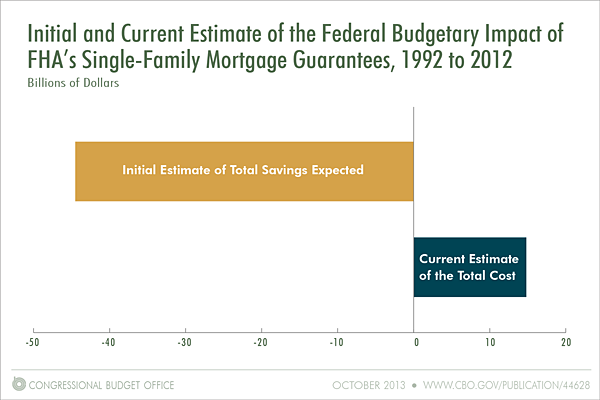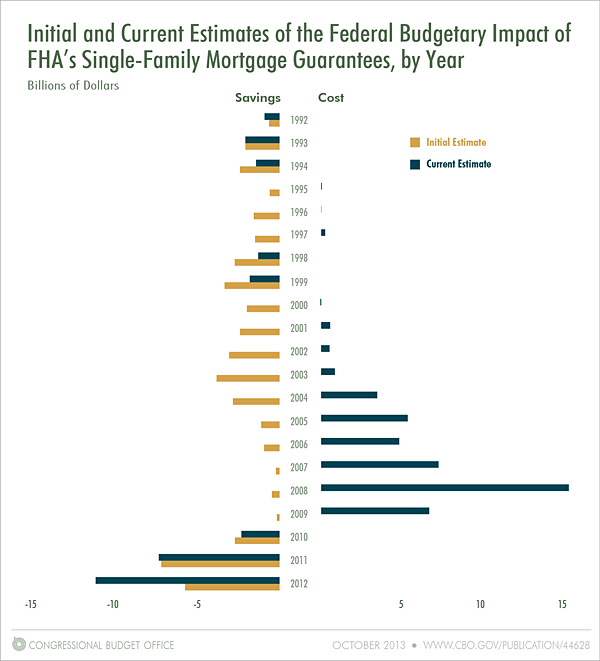The Federal Housing Administration (FHA) operates a guarantee program for single-family mortgages that aims to extend access to homeownership to potential buyers who lack the savings, credit history, or income to qualify for conventional mortgages. Under the program, FHA insures certain mortgages issued by private lenders, in exchange for a fee. If a borrower fails to make a payment or defaults on an insured mortgage, the FHA pays the issuer or holder of the mortgage the amount due. (FHA operates a similar program for mortgages on multifamily residences.)
CBO receives many questions about the budgetary cost or savings of this program. Most recently, we have received some questions concerning the $1.7 billion cash infusion FHA received from the Treasury on September 30, 2013. So, we thought it would be helpful to pull together our answers to some of those questions. The following paragraphs discuss the costs of FHA’s single-family program. Tomorrow, we will follow up with another blog post that explains the operation of the fund that records the program’s financial transactions, including the recent $1.7 billion infusion.
Has FHA’s Guarantee Program for Single-Family Mortgages Produced Net Savings to Taxpayers?
No. Collectively, the single-family mortgage guarantees made by FHA between 1992 and 2012 have had a net federal budgetary cost of about $15 billion, according to the most recent estimates by FHA. In contrast, FHA’s initial estimates of the budgetary impact of those guarantees sum to savings of $45 billion (see the figure below). That swing of $60 billion from savings to cost primarily reflects higher-than-expected defaults by borrowers and lower-than-expected recoveries when the houses of defaulted borrowers have been sold—especially for loans made over the 2004-2009 period.

Those estimates of net budgetary impact were calculated using the methodology established by the Federal Credit Reform Act of 1990 (FCRA), which is discussed below. Under that methodology, the estimated costs or savings associated with FHA’s mortgage guarantees can change each year until the mortgages are repaid, refinanced, or otherwise closed out (such as through a payout on a default).
The federal budgetary impact of FHA’s single-family mortgage guarantees varies greatly among guarantees made in different years (see the following figure and the table of data at the end of this blog post):
- The swing from expected savings to expected cost mostly stems from guarantees made over the 2001-2009 period, with those made in 2004 through 2009 now estimated to have significant costs rather than the small savings that were originally estimated.
- Mortgage guarantees made in 2010 through 2012 are currently estimated to produce savings for the federal government, although those guarantees have only a few years of performance history thus far. For guarantees made in those years, FHA has collected larger fees and imposed stricter criteria for determining which mortgage applications are approved.

How Is the Federal Budgetary Impact of FHA’s Single-Family Mortgage Guarantees Estimated?
Under FCRA, the budgetary impact of a federal loan or loan guarantee is not captured by the associated cash flows in each year but by the expected present value, in the year the loan is disbursed, of all of the cash flows over the life of the loan or loan guarantee. (A present value is a single number that expresses a flow of current, past, and future income or payments in terms of an equivalent lump sum received or paid today.) That budgetary impact is known as the subsidy cost (or savings) of a loan or loan guarantee. For FHA’s single-family mortgage guarantees, the subsidy cost is the estimated net present value of the government’s receipts from fees and the government’s expenses from defaults (net of recoveries).
Under FCRA, interest rates on Treasury securities of comparable maturity are used in calculating net present values.
The subsidy cost of a loan guarantee is recorded in the budget during the year in which the guarantee is made. But FCRA also calls for an annual review of the budgetary impact of loans and loan guarantees to account for any changes in observed or projected interest rates and for data on loan performance. The difference between the current estimate of that budgetary impact and the previous estimate is referred to as a credit reestimate, and it is recorded in the budget in the year the reestimate is made. (Those estimates are provided by the Office of Management and Budget in the Federal Credit Supplement that accompanies the President’s annual budget proposal.)
What Are “Negative Subsidies” and How Do They Arise?
Since 1992, FHA has estimated budgetary savings—or “negative subsidies”—for each annual cohort of single-family mortgage guarantees in the year the guarantees were made. The expected savings equaled the product of the value of mortgages guaranteed and the estimated subsidy rates for the guarantees. The negative estimated subsidy rates indicate that fee collections were expected to exceed expenses from defaults (net of recoveries) on a present-value basis. Over time, however, the estimated subsidy rates for nearly every one of those cohorts of guarantees have become less negative or have turned positive.
How Is the Estimated Budgetary Impact of Mortgage Guarantees Affected by Using Treasury Rates to Discount Future Cash Flows?
Before FCRA took effect, the federal budget recorded the transactions associated with government credit programs on a cash basis. FCRA was intended to improve the measurement of the budgetary impact of those programs by recording in the budget the expected lifetime cost of certain financial obligations at the time those obligations are incurred.
Under FCRA, expected lifetime costs equal the present value of expected future cash flows discounted using Treasury borrowing rates. CBO has also analyzed an alternative approach to accounting for federal credit programs—so-called “fair-value” estimating—in which a premium is added to the Treasury rate used for discounting to capture the additional compensation that investors would require to bear the risk associated with those programs. In CBO’s judgment, the fair-value approach provides a more comprehensive estimate of federal costs.
Federal credit programs have larger estimated costs (or smaller estimated savings) under the fair-value approach than under FCRA accounting. In 2011, CBO estimated that FHA’s single-family mortgage guarantee program would produce budgetary savings of $4.4 billion for mortgages guaranteed in 2012 on a FCRA basis but a budgetary cost of $3.5 billion on a fair-value basis. Those figures stem from an estimated mortgage guarantee volume in 2012 of $233 billion and estimated subsidy rates of negative 1.9 percent and positive 1.5 percent on a FCRA basis and a fair-value basis, respectively. (For more discussion of the fair-value approach to estimating costs for FHA’s single-family mortgage guarantee program, see the analysis that CBO published in May 2011.)

Chad Chirico and Susanne Mehlman are analysts in CBO’s Budget Analysis Division.

